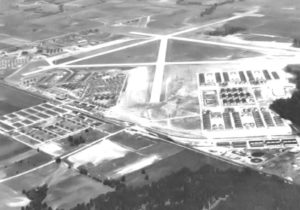
“With the outbreak of World War II, the GHQAF move to Scott was cancelled. Instead, Scott Field reverted to its former role as a training installation. On 1 June 1939, one of Scott’s Balloon Groups was redesignated as a headquarters unit of the Scott Field Branch of the Army Air Corps Technical Schools. Subsequently, various technical schools moved to Scott. Its communications training era began in September 1940 with the opening of the Radio School.”
“After September 1940, the primary wartime mission of Scott was to train skilled radio operator/maintainers; to produce, as the Radio School’s slogan proclaimed, “the best damned radio operators in the world!” Scott’s graduates flew in aircraft and operated command and control communications in every Theater of the War, and were often referred to as the “Eyes and Ears of the Army Air Forces.” By the end of World War II, Scott’s Radio School—becoming something of a “Communications University of the Army Air Forces”, where it expanded during the war to fill about 46 large school buildings on base. It was from this course that many specialized radio and communications courses evolved, and had graduated 77,370 radio operator/mechanics. While all had been important to the nation’s victory, two of the schools better known graduates were Medal of Honor recipient Technical Sergeant Forrest Lee Vosler, and the future first Chief Master Sergeant of the Air Force, Paul Airey.”
“Though the Radio School was the primary World War II-era mission, it was not intended to be Scott’s only mission. The Air Corps had also planned for Scott to become a major air terminal due to its centralized location in the United States. In 1940, a $1 million project began to construct four mile-long concrete runways. Though not fully completed until November 1942, the portions that were complete provided a capability to give advanced flying school graduates instruction in instrument and night flying, navigation, photography, and administrative flights. By late 1943, the Radio School students were in the air as well, practicing code transmission under actual flight conditions. Unfortunately, airfield operations had to be sharply curtailed in May 1944, after an accidental tool-spark set fire to Hangar 1—Scott’s only hangar. Repairs were not completed until May 1945.”[1]from Wikipedia
References
| ↑1 | from Wikipedia |
|---|
